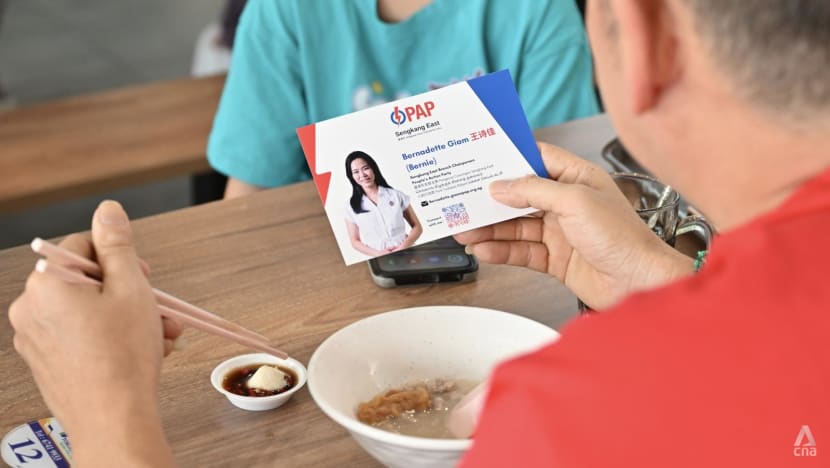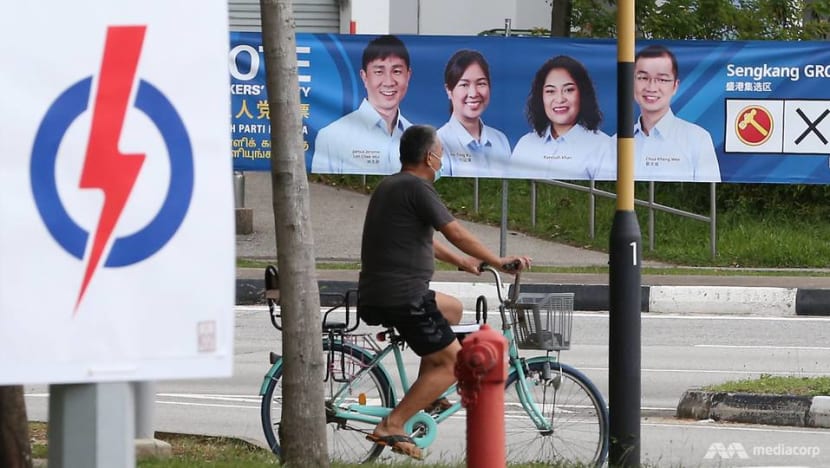As Singapore's political parties gear up for post-pandemic election, printing firms await business boom
One company has already been notified by MPs to be on standby for multiple orders - which can go up to half a million pamphlets in some constituencies.

PAP’s Sengkang GRC’s new face, Bernadette Giam, hands out a flyer to a resident at 170A Rivervale Shores on Feb 1, 2025. (Photo: CNA/Jeremy Long)

This audio is generated by an AI tool.
SINGAPORE: Political parties in Singapore have begun gearing up for this year’s general election hustings by preparing orders for physical collaterals such as flyers and posters, firms in the sector told CNA.
Orders could number as high as over half a million pamphlets in hotly contested constituencies, such as battlegrounds between the ruling People’s Action Party (PAP) and the opposition Workers’ Party (WP), industry players said.
Printing firms in Singapore are already looking forward to a boom in business.
Republic Holdings has been printing collaterals for both the ruling party and various opposition parties for over 20 years, said the firm’s director Ben Ang.
“During the election year, we usually see a spike in sales of up to 50 per cent at least,” said Mr Ang, whose firm focuses mainly on flyers.
“Some parties do take this very seriously as this is a proven method to let the residents know more about them.”
Mr Ang said parties typically place orders up to six months in advance. He has already been notified by various politicians to be on standby for multiple orders this year.
Each candidate typically orders at least 100,000 pamphlets, which takes about three to five working days to deliver, said Mr Ang.
Prices start from S$45 for 100 pieces and vary based on factors such as size, quantity and type of paper used, according to the firm's website.
Print&Print, another firm which has been in the business since 1990, regularly prints physical materials for both PAP and WP-run town councils as well as for election campaigning needs of both parties.
Parties typically finalise their orders four to five days before the hustings begin, said its manager Cynthia Oh.
During such time, there’ll be a 15 per cent increase in orders for banners, posters and other collaterals such as tissue packets and fans, said Ms Oh.

Industry players told CNA they naturally receive more orders in hotly contested constituencies, as candidates bid to capture the attention of as many voters as possible.
Some Group Representation Constituencies (GRCs) — which currently comprise four or five seats — can even order over half a million pamphlets, said Mr Ang.
“Traditionally, PAP versus WP GRCs are hotly contested and hence might see much more orders,” explained Mr Ang. In the 2020 contest, the two parties faced off in Aljunied, Marine Parade, Sengkang and East Coast GRCs.
A PERSONAL TOUCH
In 2020, over 85 per cent of what all candidates spent went towards advertising, according to Elections Department records.
Of that sum, print election advertising formed the majority, amounting to S$5.6 million.
Mr Ang said flyers were particularly crucial when going door to door.
“If no one is home, the flyer can be slotted into the house. Your trip will not be wasted,” he said.
Murdoch University’s adjunct professor of media and communication Terence Lee told CNA that research points to face-to-face or physical forms of human communication as generally more persuasive than digital forms.
“In much the same way a 'live' music concert generates 'fan' support, the same is true for physical election campaigning.
And this includes knocking on doors to meet residents and handing out flyers, regardless of whether they are read, said Adj Prof Lee.
Banners, flags or posters meanwhile can only be publicly displayed during the campaigning period – which starts immediately after nomination proceedings end on Nomination Day and up to the start of the eve of Polling Day – and only in designated locations.
Such visuals are needed more by the new challengers in a ward than the incumbent MPs, when it comes to candidate recognition, said Adj Prof Lee.
Physical materials also better safeguard against misinformation, said Assistant Professor Saifuddin Ahmed from Nanyang Technological University’s Wee Kim Wee School of Communication and Information.
Printed materials are perceived as more legitimate compared to digital content, which can be manipulated or ignored,” he said.
It’s also easier to skip or miss digital advertisements while physical posters can provide greater visibility for candidates, especially in high-traffic or populated areas, said Asst Prof Saifuddin.
DIGITAL DOWNSIDES
Observers noted that certain segments of society such as some older individuals may not be tech-savvy and prefer traditional campaign materials.
Associate Professor Natalie Pang, who heads the communications and new media department at the National University of Singapore, noted that the digital information environment was already a very crowded one.
“In fact, it may be even harder to connect with voters that are not already following (parties) on the platforms.”
Assoc Prof Pang noted that while physical materials can cost more to print and are labour intensive to distribute, materials distributed via digital channels require deeper expertise in terms of understanding different online platforms, and moderating and engaging voters in that space.
In the coming general election, which must be held by Nov 23, finding the right mix between physical and digital domains of outreach will be crucial for parties, she said.
A DIFFERENT GE
Since the last electoral contest, there have also been changes in legislation governing outreach in the political domain.
One key change, said Adj Prof Lee, is the law banning deepfakes and other digitally manipulated content of candidates during elections, which Singapore's parliament passed in October last year.
There is also the 2021 Foreign Interference (Countermeasures) Act or FICA, which in tandem with the Protection from Online Falsehoods and Manipulation Act or POFMA, would be “sufficient to rein in electoral mis- or disinformation in political advertising,” said Adj Prof Lee.
For industry players, a return to an election without the constraints of 2020’s pandemic safety measures simply represents business opportunities.
Ms Oh expects a “resurgent interest in physical marketing materials”, with printed collaterals playing a key part in a hybrid strategy parties will likely adopt to reach voters.
Mr Ang meanwhile expects candidates to engage with voters in person more freely, hold large rallies and organise events.
“This opens up a lot more opportunities for direct interaction and on-the-ground campaigning. We expect huge volumes of marketing materials to be involved too.”
Business is also business and unaffected by political leanings.
“We view all political parties equally and wish them well,” said Mr Ang. “We also charge all of them the same rate.”





















